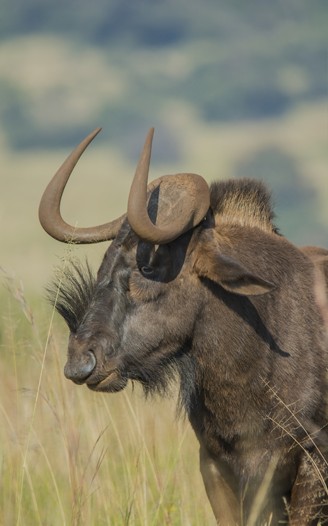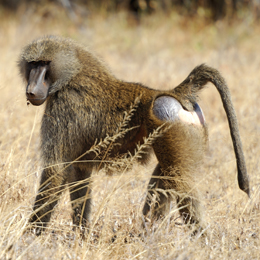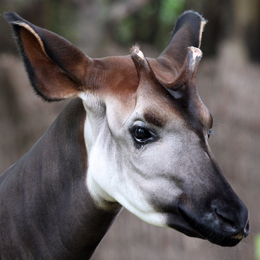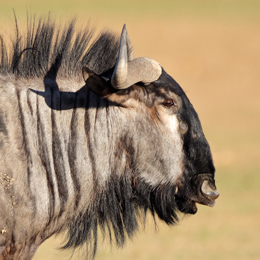Black Wildebeest
The Black Wildebeest was first described by a German zoologist and geographer, Eberhard August Wilhelm von Zimmermann in 1780. The mammal is also known as the White-tailed Gnu because of its creamy-white tail closely resembling the mane of a horse whereas the word ‘Gnu’ has been derived from a Khoi-khoi word that refers to this animal’s typical snort “ge-nu”.
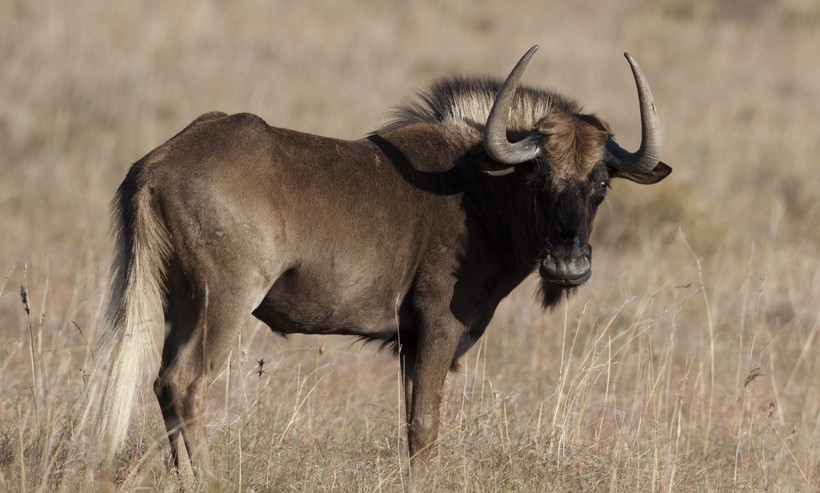
Black Wildebeest, Mountain Zebra National Park, South Africa
?
Image credits: Mogens Trolle/Shutterstock
The average weight of Black Wildebeest ranges between 110 and 180 kg (240-400 lb) and the average head-body length is between 170 and 220 cm (67-87 inches). Males of this species are usually taller than females with the average shoulder height of males being 111-121 cm (44-48 inches) whereas for the females it is 106-116 cm (42-46 inches). These animals are mainly characterized by their long, white horse-like tail and the dark-colored hair under their belly in between their forelegs.
The Black Wildebeest lives in three types of social groups: the territorial bulls, the bachelor herds and the female herds. These animals are extremely fast runners with their maximum running speed being 80 km/hr (50 mph). Their resistance to fatigue is very high which allows this animal to keep running at a very high speed for a longer time without losing much energy.
Their communication involves various types of visual as well as vocal methods. Individuals of this species can live up to twenty years in the wild.
Black Wildebeest vs Blue Wildebeest
Despite the bull-like appearance of Black Wildebeest, this animal actually belongs to the family of antelope with all species of wildebeest being categorized in the Genus Connochaetes. This White-tailed Gnou shares its genus with only one other species of wildebeest, known as the Blue Wildebeest (Connochaetes taurinus).
Both Black and Blue Wildebeest share a close taxonomic relationship and both are native to Africa. However, the Black Wildebeest mainly prefers dwelling in the open grasslands while its Blue counterpart can live in different types of habitat ranging from open grasslands to woodlands to even semi-desert areas.
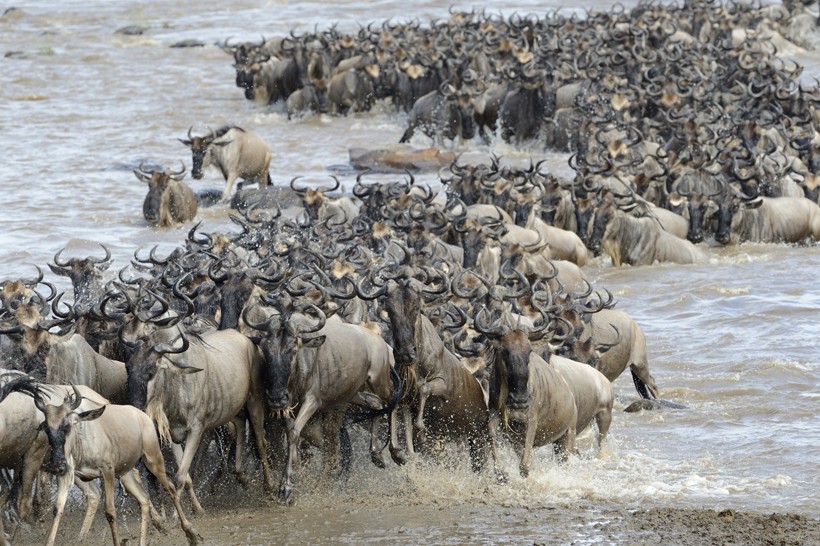
Blue wildebeests (image) are known for their migration
?
Image credits: AndreAnita/Shutterstock
Regarding appearance, the coat of Blue Wildebeest is grayish with a blue sheen and the animal is much larger than the Black Wildebeest with a maximum height of 150 cm (59 inches) and a weight of 250 kg (551 lb). Moreover, the horns of Black Wildebeest go forwards before going up in a curve while in Blue Wildebeest, the horns go sideways before curving up.
Another prominent distinguishing character between these two species is their tail which can be seen as white in Black Wildebeests and black in case of Blue Wildebeests.
Wildebeest hybrids
Black wildebeest have been found to frequently hybridize with its Blue relative. Both the sexes of Black and Blue Wildebeest can often be seen mating with each other if they are living in the same area. The offspring born from such inter-species copulation is usually fertile. However, a study carried out in the Spioenkop Dam Nature Reserve in South Africa revealed that many of these hybrid animals carry disadvantageous abnormalities in their teeth, skull and horns. Another study focused on these hybrid animals found that the hybrid offsprings are much larger than either of their parents.
Anatomy and Characteristics
The color of the coat of Black Wildebeest ranges from dark-brown to black which can be seen a slightly paler during summer but coarser and shaggier in winter time.
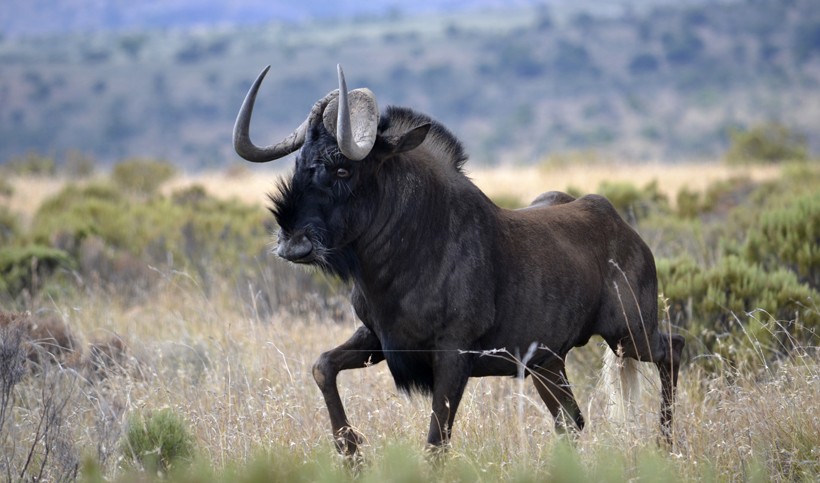
A male Black Wildebeest usually has a darker colored coat than females.
?
Image credits: Roy Coetzee/Shutterstock
A male Black Wildebeest usually has a darker colored coat than females. Similar to Blue Wildebeests, they have bushy manes tipped with a dark-brown color that sticks up at the back of their neck. This mane is mainly a mass of white or creamy white hair with dark tips. Moreover, black bristly hair can be seen under the jaw and on the muzzle. The underbelly between the forelegs also has long and dark hair. Besides the characteristic mane and hair, this animal has a thick neck, plain back and small, beady eyes.
Both males and females of black Wildebeest have strong horns that curve forward in a downward motion before going up like hooks. The length of these horns can be as long as 78 cm (30 inches) although the horns in females are somewhat thinner and shorter. As the wildebeests grow up, the flattened base of their horns become wider and thicker forming a protective shield around their skull.
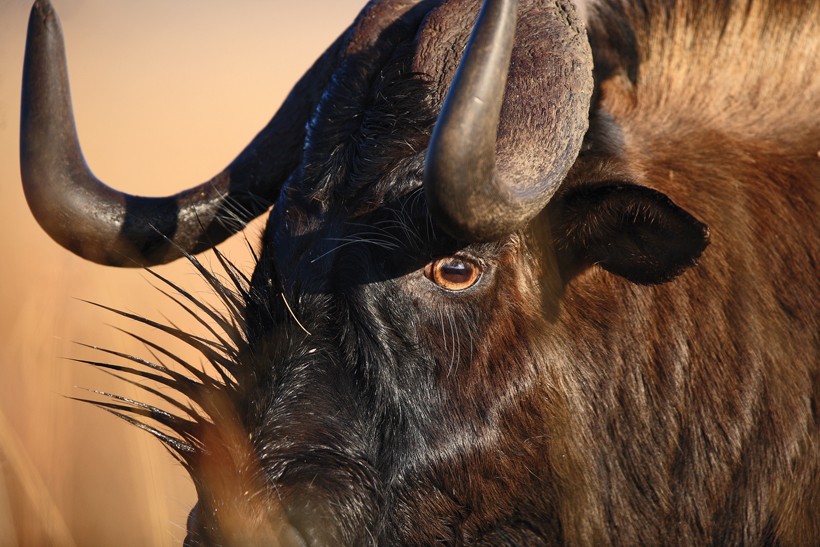
Black Wildebeest closeup
?
Image credits: Erwin Niemand/Shutterstock
In females, the horns become fully developed by the age of three while males develop their full grown horns between the age of four and five. Scent glands secreting a glutinous substance are present under their hair tufts right in front of their eyes and also on their forefeet.
Habitat
The Black wildebeest is endemic to South Africa. The historic range of habitat of the mammal included the open plains and grasslands of South Africa, Lesotho and Swaziland. Due to excessive hunting pressure, this animal almost became extinct in the latter two countries. However, the mammal has been reintroduced. Currently, an estimated 7,000 Black Wildebeests inhabit the grasslands of Namibia.
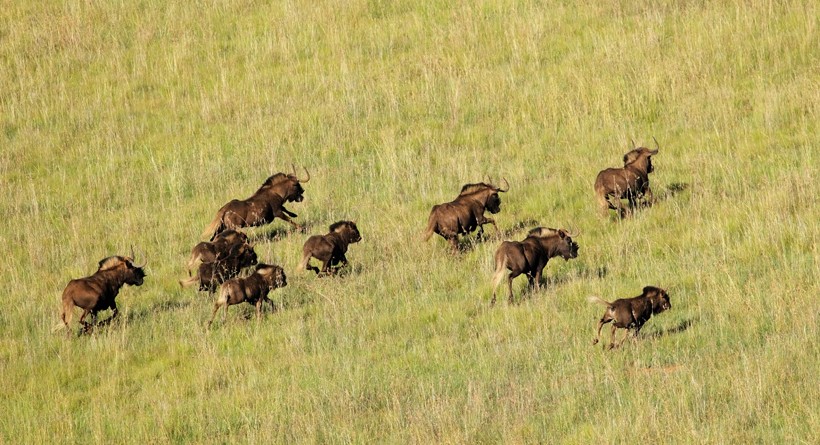
Aerial view of black wildebeest running in grassland, South Africa
?
Image credits: EcoPrint/Shutterstock
The habitat of Black Wildebeest mostly involves grasslands, open plains and Karoo Shrublands of the steep mountainous regions as well as the lower undulating hills with an altitude that ranges from 1,350 – 2,150 meters (4,430 – 7,050 ft). When the herds of these animals do not migrate, they tend to have a regular home range that covers around 1 km2. However, the home range of female herds of Black Wildebeest can cover an area of around 250 acres.
Before the massive hunting of Black Wildebeest began in the 19th century, these antelopes roamed in large numbers over the arid Karroo region on rainy seasons and the Highveld Temperate Grasslands in winter season. However, due to extensive hunting of these animals by humans, the species of Black Wildebeest completely disappeared from these terrains and the few that survived had to limit their habitat within the protected reserves and game farms of South Africa.
Diet and Predation
Diet
Black Wildebeests are herbivores that mostly prefer to graze on the short grasses available within its habitat. They generally avoid grazing on longer vegetation that is more matured. During the dry season when grasses become scarce, these grazers can be seen feeding on the available herbs and shrubs. Although 90 % of their diet normally consists of grasses, during the dry season this decreases to 63 %. They like to consume water everyday but are also endowed with the ability to survive without water for several days during the dry season when most water sources dry up.
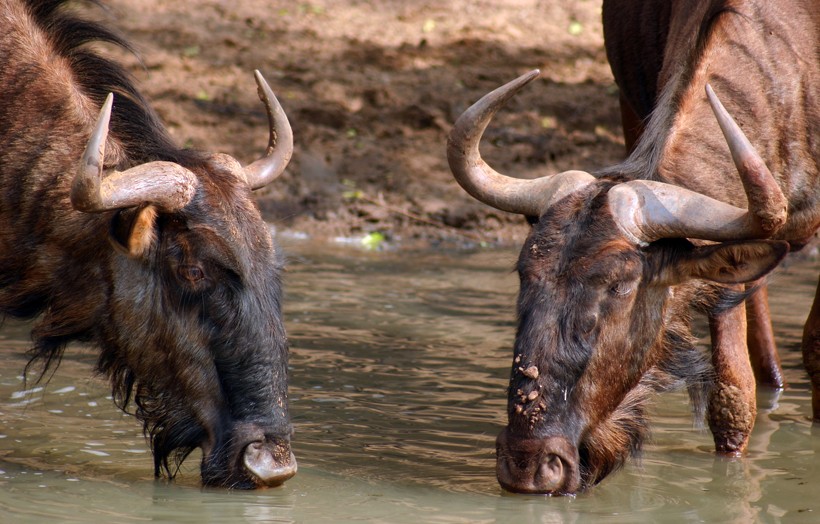
Black wildebeests drinking from a water hole in South Africa
?
Image credits: wcpmedia/Shutterstock
Predation
Lions, Leopards, Cheetahs, Hyenas, Cape hunting dogs and (nile) Crocodiles are some of the prominent predators of Black Wildebeest. In the past, when Black Wildebeests were available in large numbers, they played a major role in the ecosystem by being the main prey animal for large predators like Lions and Cheetahs. However, due to rapid declination of their population, the remaining small populations of Black Wildebeests are now confined to some limited and protected areas with only a few large predators. Therefore, the level of predation on this antelope by its natural predators is quite low.
Reproduction and Life Cycle
The males of Black Wildebeest attain sexual maturity by 3 years whereas females become capable of breeding after two years. These animals breed only once a year. The breeding season of Black Wildebeest occurs between the months of February and April which also marks the end of the South African rainy season.
A dominant bull usually has a harem of female Black Wildebeest with which he mates and also defends the harem from other males when they approach for mating. When a female member of the harem comes into estrus, the dominant male keeps her in sharp focus and copulates with her several times. An estrus female displays her condition by raising her tail and swishing it across the face of an approaching bull.
The sexual behavior of the males includes herding the female wildebeest by stretching low with ears down and sniffing at the female’s vulva while frequently touching the female’s rump with the chin and performing a ritual urination. A male in rut neither eats nor rests if there are females roaming or foraging within his territory. During copulation, the tail of the female Black Wildebeest remains up or vertical with the back arched and legs bowed. An estrus female usually mates with one male for about dozens of times before separating.
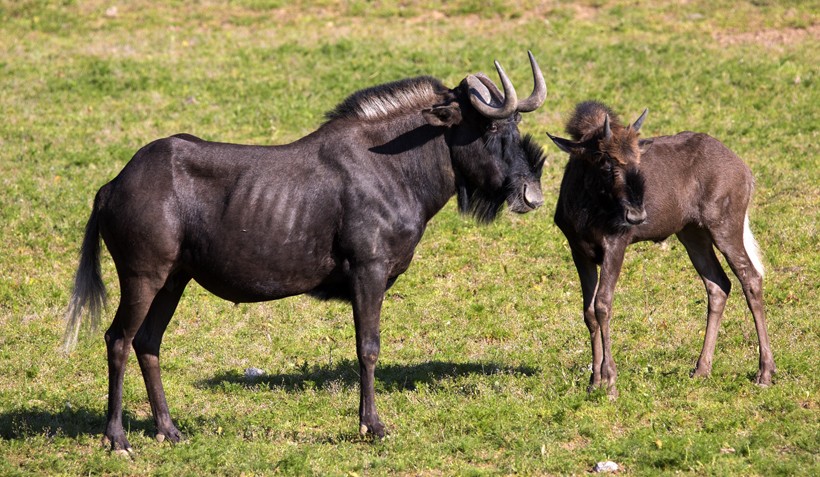
Black wildebeest with Calf
?
Image credits: Vladislav T. Jirousek/Shutterstock
The gestational period of a female Black Wildebeest lasts approximately for 8 to 8.5 months after which she gives birth to a single calf. Calving peaks are seen during November and December right after the start of the rainy season. Similar to other herbivores, calves of Black Wildebeests can stand on their own feet and start following the herd shortly after birth.
At the time of birth, the calf weighs about 11 kg and its body is covered by a tawny and shaggy coat. After the fourth week, the young develops the four incisors in its jaw and two knob-like horn-buds on its head that develops into horns as it grows up. They start nibbling on soft grasses at four weeks and keeps on suckling for about six to eight months.
Diseases
The species of Black Wildebeest is very prone to anthrax and there are many records of this animal being a victim of deadly outbreaks. This animal has been known to get affected by Ataxia and Heartwater (Ehrlichia ruminantium) which is a rickettsial disease. Similar to its relative the Blue Wildebeest, the Black Wildebeests also get fatally affected by foot-and-mouth disease and rinderpest which is also known as cattle fever. Moreover, both Wildebeests serve as a reservoir or carrier for the virus called gammaherpesvirus that causes fatal diseases (Malignant catarrhal fever) among domestic cattle. These animals do not show any symptoms although they get infected by this virus which is transmitted by the mother to her calf either during gestation or right after birth.
Behavior, Communication and Intelligence
Black Wildebeests remain most active during early morning and late afternoon. These animals communicate among themselves by using pheromones, which they detect by flehmen that involves curling back the upper-lip and exposing the front teeth. The wildebeests also use different types of vocal communications, some of which can be heard from a mile away. When approached by humans, this animal responds by snorting and running a short distance while stopping abruptly to look back at the person and repeating this behavior several times.
Black Wildebeests are gregarious animals that live in three distinct groups involving female herds, bachelor herds and solitary territorial bulls. The female herds mainly consist of matured females and their offspring. The number of female wildebeests in one group can vary from 14 to 32 depending on the abundance of food. The female members of these herds tend to have a very strong attachment to each other and can become very aggressive towards other females who might attempt to join their group.
Large herds of female Black Wildebeest often divides into smaller groups. The small calves remain very close to their mother while older calves form groups within the herd.
The mother generally repels the young male calf before the start of the next calving season. These young males then join the bachelor herds that consist of other yearlings and bulls that are unsuccessful in gaining a territory.
Territorial bulls are matured bulls over four years old. They establish their own territories and maintain it throughout the year. These bulls only allow female herds to pass through their territory. Each area of a territorial bull is separated by a distance of around 100 – 400 m (330 – 1,310 ft). Within his territory, the bull selects a certain patch of ground at the center where he defecates regularly and also performs certain acts of display like urinating, pawing, scraping, rolling and thumping the ground with its horns. This behavior demonstrates his prowess and territorial power to other bulls.
Population and Conservation Status
The major population of Black Wildebeest is restricted to private reserves and protected areas in South Africa. In the past, however, these animals occurred also in large numbers in both Swaziland and Lesotho. But, excessive hunting in the 19th century reduced the population of Black Wildebeest to just a few individuals on two private farms in South Africa. Therefore, extreme conservation efforts had to be carried out by the government and other agencies in order to prevent this antelope from getting extinct, which resulted in the recovery of the lost population to some extent.
At present, the total population of Black Wildebeest has been estimated to be more than 18,000. It has been reintroduced to its former range of habitat in western Swaziland and Lesotho where the population has been reported to be increasing. Besides its natural range, the Black Wildebeest has also been introduced in Namibia where its number has flourished substantially within a decade. Currently, an estimated 7,000 Black Wildebeests inhabit the grasslands of Namibia. Due to the increasing number of Black Wildebeest in South Africa and Namibia, the IUCN Red List has listed Black Wildebeest in the category of ‘Least Concern’ as the threat of extinction has lessened considerably for this species.
Cultural Depiction
In South Africa, the herds of Black Wildebeest are a major attraction for tourists and its image is used in depicting various places and products of South Africa. The Province of Natal depicts the Black Wildebeest on their coat of arms. The South African government has also issued stamps depicting this animal and even has coins with showing this Wildebeest.
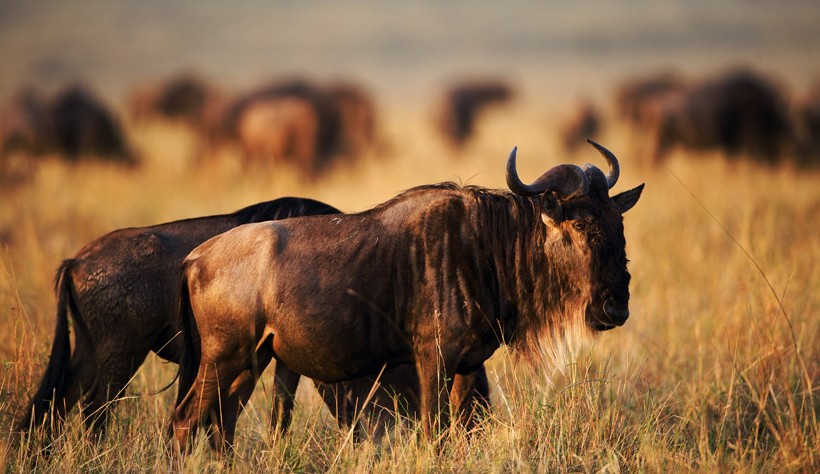
Black Wildebeest, sunset Africa
?
Image credits: Sergey Uryadnikov/Shutterstock
Besides the image, the coat of Black Wildebeest is used for making leathers and its meat is very popular in South Africa even though it is coarse, hard and dry. The meat of this antelope is dried for making biltong which serves as an important ingredient in the South African Cuisine.
Evolutionary History
The Black and Blue Wildebeest are two species of the same genus called Connochaetes. However, in the past, the Blue Wildebeest was not considered to be a species of the same genus as the Black Wildebeest and had a separate genus known as Gorgon. But many studies confirmed that these two antelopes have too many similarities to be placed in a different genus and therefore, Blue Wildebeest was placed under Connochaetes.
It has been observed that the lineage of Black wildebeest diverged from its taxonomic relative Blue Wildebeest either in the middle or late part of the Pleistocene epoch. This animal then evolved differently to become a distinct species of antelope about one million years ago which is a very recent time on the geologic time scale. The prominent features of Black Wildebeests like the horns and their broad-based skull were also present in the body of their fossil ancestors that were found embedded in sedimentary rock in Cornelia and dates back to about 800,000 years.
Funfacts
- The Black wildebeest is an unique species of antelope that has a bull’s face, horse’s tail and buck’s leg.
- Black Wildebeests can run at a terrific speed of up to 80 km/hr (50 mph) and possess a good resistance to fatigue.
- A Black Wildebeest has the capacity to thrive in the hot and shade-less open grasslands of South Africa and can graze under the hot sun without seeking any shade.
- Black Wildebeests do not have the habit of undertaking long migrations like its larger relative Blue Wildebeests.
- Excessive hunting of Black Wildebeests for their meat almost exterminated this animal at the end of 19th century leading to their number being reduced to just a handful of individuals.
